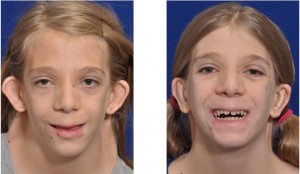Background: The webbed neck deformity is a congenital skin fold disorder that runs along the sides of the neck to the shoulders. Known technically as the pterygium colli deformity, it is known to occur in a large number of medical conditions but the most common are the genetic conditions of Turner’s and Noonan syndrome as well as Klippel-Feil syndrome. At birth there are smaller loose folds of skin on the sides of the neck but with growth the webs expand outward ultimately making it look like there is little to no neck.
Surgical correction of the webbed neck deformity is a very different form of a neck lift. It is challenging because of the thickened fascia that comprises the band and a low hairline that extends down along the webs. The most common surgical techniques are the use of modified Z-plasties. A Z-plasty is placed with the midline arm down the length of the web. The subcutaneous fibrous band is excised, the shortened trapezius muscle is released, and the hair-bearingskin flap is cut out. The anterior skin flap is rotated and advanced to join its mirror image flap from the opposite side of the neck at the posterior midline. Any remaining skin dog-ears near the shoulder are corrected with additional small Z-plasties.
An alternative technique is a purely posterior neck approach using a Butterfly correction technique. In this method, a butterfly-shaped portion of redundant skin is excised posteriorly and the lateral, superior and inferior flaps joined in a double Y midline suture line or even that of an X pattern closure. The Butterfly technique avoids the unnatural hairline and noticeable scars characteristic of a lateral Z-plasty method but does so with often a less than complete correction of the webs.
Case Study: This 9 year-old female who had Turner’s syndrome had large neck webs that completely obscured any visible neck. They extended from behind her ears out to her shoulders She also had protruding ears due to a lack of antihelical folds.

She had substantial improvement in her webbed neck and ear deformities. There remained some slight medial neck bands but there were no visible scars. All scars were in the occipital hairline and on the posterior neck.
Case Highlights:
1) Webbed neck deormities are most commonly seen in congenital conditions such as Turner’s syndrome.
2) Traditional webbed neck surgeries use z-plasties along the sides of the neck which can result in visible scarring.
3) A two-stage approach to correction of the webbed neck results in no visible scars along the sides of the neck or shoulders.
Dr. Barry Eppley
Indianapolis, Indiana


